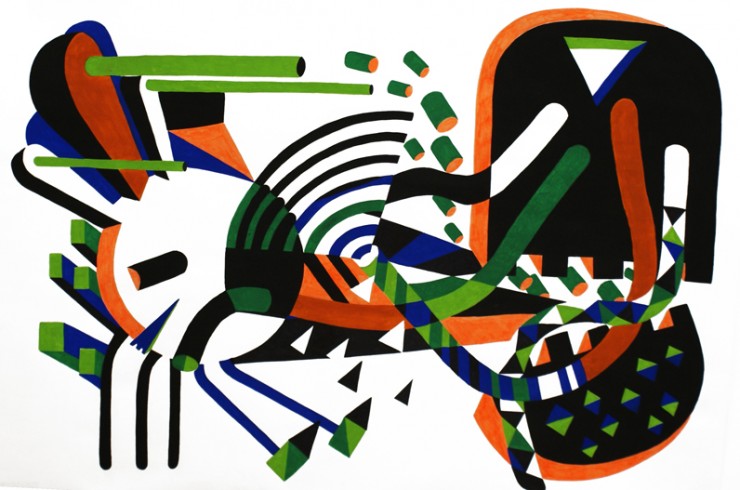Art
Imagining a tolerable reality: an interview with street artist Tifani Rubi
Giving free reign to her imagination, street artist Tifani Rubi paints vibrant creatures whose fantastic forms evoke myth, legend, and wonder tinged with dread. Having previously relocated from Rijeka, a port town in Croatia, to the creative hub of Berlin, she is now back and has big plans to revitalize the artistic scene in her hometown. Here, she tells us more about the ideas behind her work and her hopes for developing an art collective in Rijeka.
What is your creative background? How did you become interested in street art?
Street art represents the free expression of creativity and ideas, liberated from institutions’ clear white walls and settled parameters. The usurping of streets that are supposed to belong to people signifies reclaiming your right from the hands of commercial advertising, media, and the imposed aesthetics of today. That is the reason that drove me to start intervening outside, in urban areas. I started by making stickers and small paste-ups and placing them around the city. It was also very interesting to watch how long they lasted on different buildings, lampposts, etc. After some time I started doing bigger formats, which I consider my favorite and most exciting way of expression.
Tell us a bit about the characters in your work. Who are they and where do you get inspiration for them?
Every image is a reflection of the outside world, reborn in my head where I give freedom to my imagination. Every fear or a frustration with the outside world is analyzed and cut into bits and pieces, ready to be assembled again in some form of tolerable reality. It’s a chaotic visual representation of every aspect of living that I impose on myself and the viewers.
All of the characters are residing in a protective environment: they are playing with fire, missing limbs or have too many, carrying various objects with sad expressions on their faces. Still, the colors are shiny and vibrant, camouflaging my comments on the global state of mind that consciously denies basic human needs and aspirations, dehumanizing us and reducing life to a part of increasingly growing machine.
What are some of the other themes you explore with your work?
Living in a culture that changes this fast can be stimulating and a burden at the same time. The relationship between culture and nature is my primary concern. Combining lack of time with a growing wish for freedom, struggling to create [a habitat] between tall gray walls that resemble something that I crave, and at the same time trying to point out the constant dehumanization of our living environment.
You’ve spent time in both Berlin and Rijeka. How have these two cities shaped your work?
I left Rijeka at one point of my life when I felt it’s time for some radical turnover and that included everything I knew before: environment, university, the art scene in general. In Berlin I discovered another world, which helped me focus on priorities and bring positive energy and fresh ideas back home.
What is it like as an artist to live and work in both Berlin and Rijeka? Are there major differences in the art scene or in the reception of your work?
Berlin was an amazing adventure and priceless experience … The art scene is much more free of hierarchical boundaries, with no real rules and preferences, which makes it easier to get involved. You can find workshops, galleries, ateliers and art collectives occupying the most unexpected places, like abandoned factories, indoor swimming pools, and other unused public facilities. This is one of the most important elements of the Berlin independent scene – the possibility of reclaiming space to develop culture in every form.
Since I visited many of these collectives, my vision and goal is to recreate a similar space in Rijeka, a post-industrial city with many abandoned buildings just waiting to be reanimated.
What are your thoughts on the division between “fine” and “street” art?
Showing your work in spaces that are known as ‘institutions’ can be a good experience to learn how things work in a traditional way, but nowadays there is a growing number of galleries and curators who specialize in finding young, emerging artists. In my opinion their approach is more natural and less formal. I understand the need to be recognized in a community of ‘professionals’ after some years of practicing guerilla methods, but in the end, every individual artist should decide their own path regardless of the needs of the market and current trends.
Do you have any particular creative influences?
This is not an easy question to answer because it is not a rational condition. I pick up pieces from everything I encounter, assembling it into kaleidoscope of feelings and impressions composed of people, thoughts, conflicts, beauty and nature.
What are your future plans? How do you see your work evolving?
Right now I’m building my new silkscreen workshop as part of a much bigger project that involves music, concerts, exhibitions, and theater in Rijeka. The aim is to share all of our knowledge and experience with a wider group of people and introduce them to alternative, independent practice – especially DIY culture. I also hope to finish printing a whole new series of drawings by the end of this year.
Is there any particular message you want your work to communicate to viewers?
It’s important to drive people to start looking with their own eyes at the world and to create their own rules and microcosms.
Interview by: Elaine Ritchel








